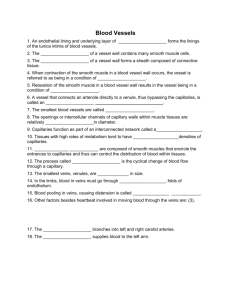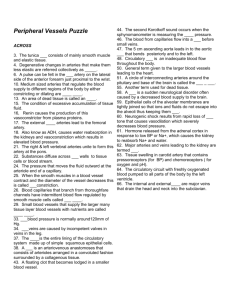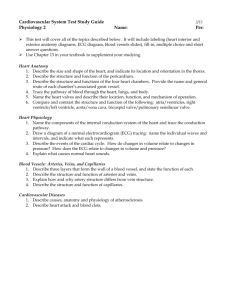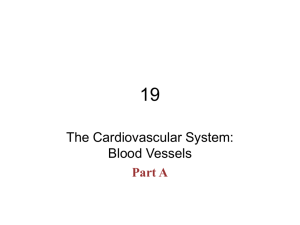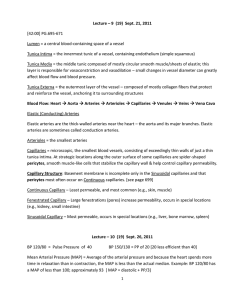The Cardiovascular System: Blood Vessels
advertisement
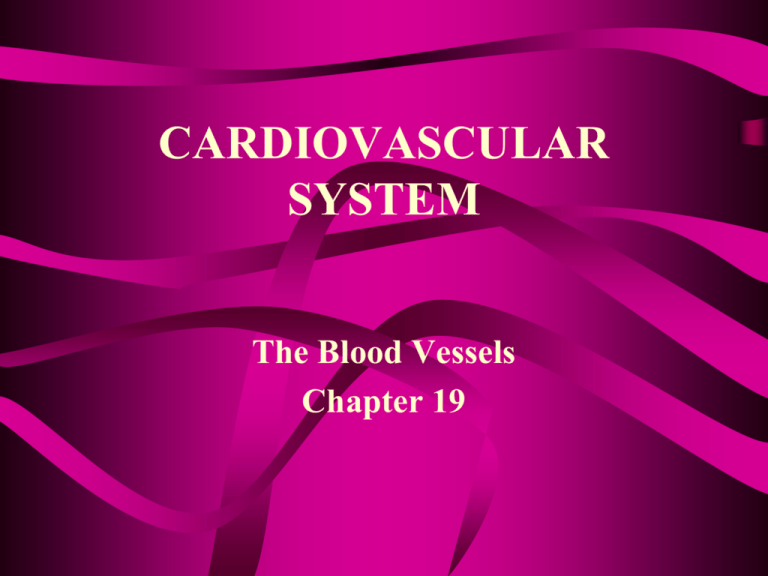
CARDIOVASCULAR SYSTEM The Blood Vessels Chapter 19 Types of Blood Vessels • Arteries=transport blood away from the heart and typically carry oxygenated blood. • Veins=transport blood toward the heart and typically carry deoxygenated blood. • Capillaries=microscopic blood vessels that allow exchange between blood and tissues. Blood Flow Arteries Capillaries Veins Layers of a Blood Vessel • Tunica interna (intima)= inner most – Endothelium • Tunica media=middle – Vasoconstriction and Vasodilation • Tunica externa (adventitia)= outermost – Vasa vasorum Arteries versus Veins Blood Flow Arteries Capillaries Veins Arterial System • Elastic arteries • Muscular arteries • Arterioles • Arterial anastomoses Major Arteries Capillaries • Characteristics – Squamous epithelium – Basal lamina – Pericytes • Types – Continuous – Fenestrated – Sinusoidal Capillary Beds • Precapillary sphincter • Metarteriolethoroughfare channels • True capillaries Venous System • Venules • Venous sinuses • Veins • Varicose Veins • Venous Anastomoses Major Veins Blood Reservoirs Vessel Comparison PHYSIOLOGY OF BLOOD VESSELS Definition of Terms • Resistance =the opposition to flow and is a measure of the amount of friction blood encounters as it passes through vessels. • Blood Pressure =the force per unit area exerted on a vessel wall by the blood contained within it (expressed in mm Hg). • Blood flow =the volume of blood flowing through a vessel, an organ, or the entire circulation in a given period. RESISTANCE Peripheral Resistance • Blood viscosity • Total blood vessel length • Blood vessel diameter BLOOD PRESSURE Blood Pressure • Arterial blood pressure – – – – Systolic pressure Diastolic pressure Pulse pressure Mean arteriole pressure • Capillary blood pressure • Venous blood pressure Venous Blood Pressure • Muscular pump • Respiratory pump Factors affecting Blood Pressure • Cardiac Output – Increased CO = increased BP – Decreased CO = decreased BP • Peripheral Resistance – Increased vasoconstriction = increased BP – Increased vasodilation = decreased BP • Blood Volume – Increased blood volume = increased BP – Decreased blood volume = decreased BP Maintaining BP (Short-term: neural) • Vasomotor centers of the medulla • Vasomotor tone • Baroreceptor-initiated reflexes • Chemoreceptorinitiated reflexes • Hypothalamus and cerebral cortex Maintaining BP (Short-term: hormones) Maintaining BP (Short-term: hormones & chemicals) • Nitric Oxide • Endothelin • Inflammatory chemicals • Alcohol and Nicotine??? Maintaining BP (Long-term: renal regulation) • Direct Renal Regulation – Blood volume – Filtrate production • Indirect Renal Regulation – Renin – Angiotensin II Factors That Increase MAP MONITORING CIRCULATORY HEALTH Vital Signs • Taking Pulse • Measuring Blood pressure • Respiratory rate • Body temperature Pulse Points Blood Pressure: Auscultatory Method Blood Pressure Disorders • Hypertension=140/90 mm Hg or higher • Hypotension=100/80 mm Hg or lower BLOOD FLOW Blood Flow • Through Tissues – – – – Brain (13%) Heart (4%) Kidneys (20%) Abdominal organs (24%) – Skeletal muscles (20%) – All others (19%) Velocity of Blood Flow • Inversely related to cross-sectional area of the blood vessel – Capillaries have low velocity! – Arteries have high velocity! – Veins have medium velocity! Regulation of Blood Flow • Short-term autoregulation: – Metabolic controls – Myogenic controls • Long-term autoregulation – Angiogenesis Regulation of Blood Flow Relationship Between Blood Flow, Pressure, and Resistance Blood flow (F) is directly proportional to the difference in blood pressure (P) between two points in the circulation and inversely proportional to the peripheral resistance (R) in the systemic flow. Therefore: F = DP R Blood Flow through Capillaries and Capillary Dynamics Capillary Transport Mechanisms • Hydrostatic pressure (HP) causes filtration or reabsorption of fluids • Colloid osmotic pressure (OP) results from the presence of large non-diffusible solutes or colloids • Net filtration pressure (NFP) = (HPc – HPif) – (OPc-OPif) Net Filtration Pressure Circulatory Shock • Hypovolemic shock =extreme blood loss • Vascular shock =blood volume normal but poor circulation due to extreme vasodilation • Cardiac shock =pump failure Blood Vessel Disorders • Atherosclerosis=plaque build up within vessel • Aneurysm=ballooning of blood vessel • Phlebitis=inflammation of a vein Blood Vessels of the Body Pages 722-744 END OF MATERIAL FOR TEST I !!!




